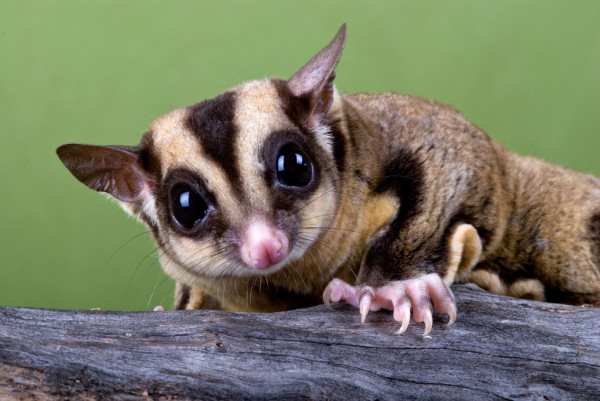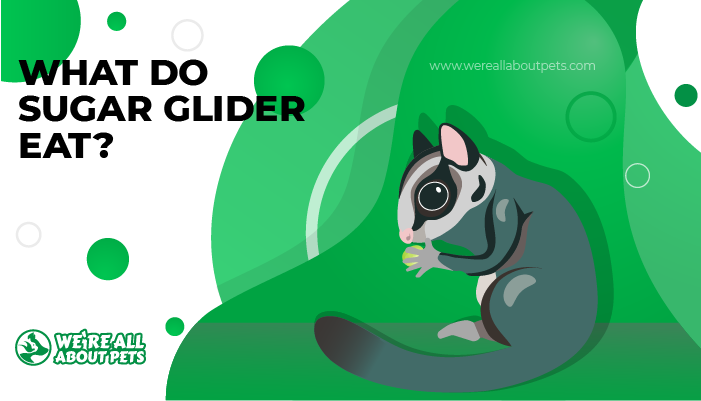How To Care For A Sugar Glider?
This page contains affiliate links. We may earn money or products from the companies mentioned in this post through our independently chosen links, which earn us a commission. Learn More
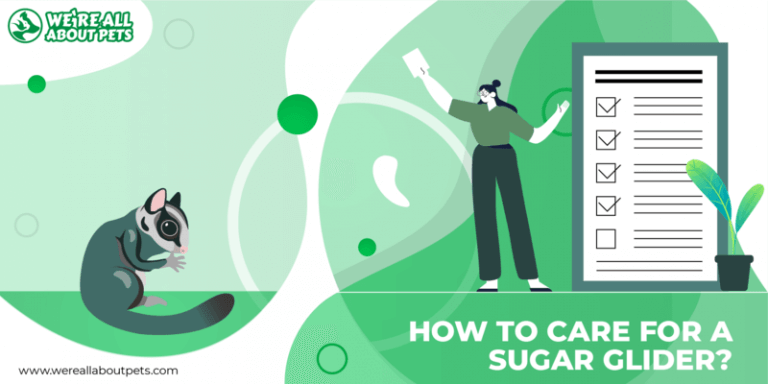
General Stats:
- Pet Type: Small animal
- Size: 5 to 6 inches
- Diet: Omnivore
- Lifespan: 10 to 15 years
Affectionately described as “pocket pets” because they can be carried around in a shirt pocket, sugar gliders are small marsupials that look like a flying squirrel. These little exotic pets are furry and friendly which makes them entertaining as pets.
Though sugar gliders are certainly unique, they are not for everyone.
Sugar gliders may not be the ideal beginner pet and they require a great deal of handling to remain tame. They also need a great deal of exercise. If you’re able to accommodate this animal’s specific requirements, however, you’ll find that sugar gliders are a joy to keep.
Here’s what you need to know about caring for a pet sugar glider.
Habitat Setup For Sugar Gliders
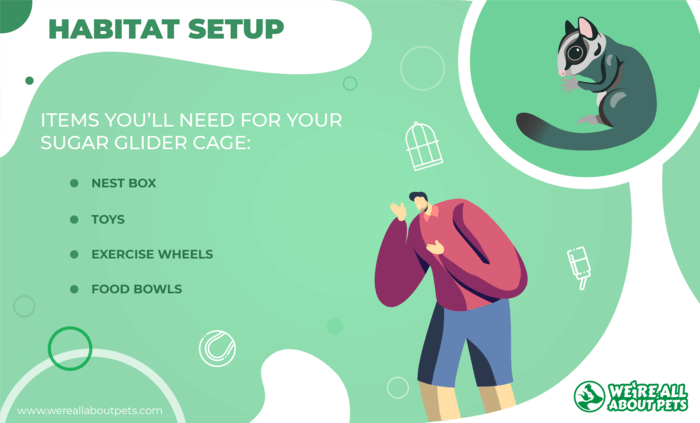
Sugar gliders may be small pets, but they are very active and require a significant amount of space. You should choose a sugar glider cage at least 24 inches wide by 24 inches deep by 36 inches high for a pair of sugar gliders, though a larger cage is always better.
Here are some of the items you’ll need for your sugar glider cage:
- Nest Box – Because sugar gliders are nocturnal animals, your pets will spend the majority of the day sleeping. Provide a nesting box padded with comfy material for your pet and his cage mates.
- Toys – Sugar gliders are active and inquisitive, so provide plenty of toys and things for your pet to play with. Bird toys are a great option, and you should include plenty of ropes, branches, and ladders for climbing.
- Exercise Wheels – Though sugar gliders have a special gliding membrane, they don’t actually fly – they tend to climb. Your pets need an exercise wheel to work off their energy. Make sure it is an enclosed wheel, so your pet’s tail doesn’t get caught.
- Food Bowls – Provide several food dishes throughout the cage for different types of food so your sugar gliders can forage. Clean the bowls frequently, at least once a day.
When it comes to choosing a cage for your pet sugar gliders, keep safety in mind.Look for a cage made from sturdy materials with wire spacing no more than half an inch wide – the bars should be horizontal as well so your pets can climb more easily.
Place your sugar glider cage out of direct sunlight and away from areas that might have a draft.
If you choose to use bedding in the cage, make sure it is nontoxic. Avoid cedar and pine shavings in favor of aspen or fir. Better yet, use a natural fiber bedding like Carefresh or simple fleece.
Also Read: The Cost Of Owning A Sugar Glider
Sugar Glider Diet
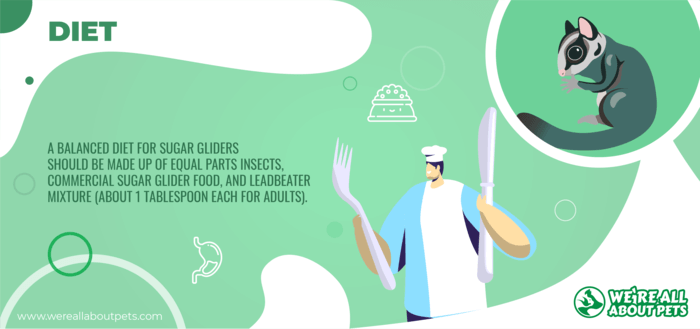
Technically speaking, sugar gliders are omnivores because they eat both plant and animal materials. What you need to remember, however, is that a wild sugar glider’s diet consists primarily of nectar and tree sap, though these small animals will also eat fruit, insects, and even small birds.
A proper diet for sugar gliders can be tricky to achieve without following a specific recipe called Leadbeater’s formula. Developed originally for the Leadbeater’s possum, this mixture is often used as a staple diet for sugar gliders in captivity.
Here are some quick facts about the ideal sugar glider diet:
- A balanced diet for sugar gliders should be made up of equal parts insects, commercial sugar glider food, and Leadbeater mixture (about 1 tablespoon each for adults).
- Sugar gliders can eat a variety of insects including moths, beetles, and crickets – mature insects are better than larval stage insects like mealworms because they are high in fat.
- Be sure to gut-load any insects you feed your sugar glider to maximize their nutritional value – feed the insects healthy fresh foods before offering them to your sugar glider.
- Make your own Leadbeater mix or buy it commercially – it is made from a combination of water, honey, baby cereal, boiled egg, and powdered calcium supplement.
- Provide your sugar glider with small amounts of fresh fruit and veggies – they prefer sweet foods like sweet potato, papaya, and corn.
In addition to food, be sure to provide your pet with unlimited access to fresh water as well.
In the wild, sugar gliders get the majority of their hydration from food, but you’ll need to provide a water bottle. A small pet water bottle is perfectly fine – just make sure to clean it and refill it on a daily basis.
Also Read: What Do Sugar Gliders Eat?
Sugar Glider Veterinary Care
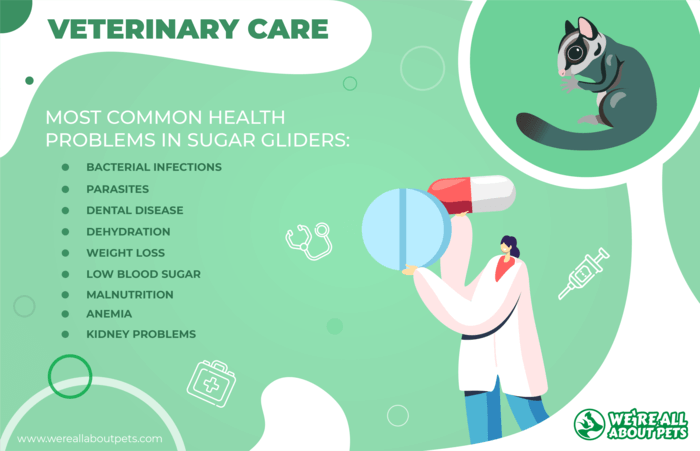
Sugar gliders are also prone to stress and can sometimes resort to self-mutilation. It’s important to keep an eye on these critters to make sure they’re getting along and to talk to your vet immediately if you notice signs of self-mutilation like missing fur or open wounds.
Here are some other common health problems in sugar gliders:
- Bacterial infections
- Parasites
- Dental disease
- Dehydration
- Weight loss
- Low blood sugar
- Malnutrition
- Anemia
- Kidney problems
- Metabolic bone disease
Because sugar gliders can succumb to illness very quickly, it’s important to have a vet on call. You’ll need to find an exotic vet in your area and take your pet in for a checkup once or twice a year.
Treatment for sugar gliders can be expensive, so consider a pet insurance plan.
Just know that not all plans cover exotic pets and there’s always the possibility that your pet will stay healthy and you’ll have paid a monthly premium for nothing. It’s up to you to weigh the pros and cons and to do what’s best to ensure optimal sugar glider care.
Sugar Glider Fun Facts
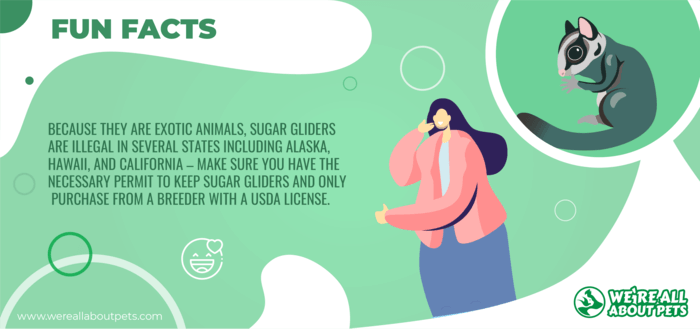
- Because they are exotic animals, sugar gliders are illegal in several states including Alaska, Hawaii, and California – make sure you have the necessary permit to keep sugar gliders and only purchase from a breeder with a USDA license.
- Sugar gliders are marsupials, so while they give birth to their babies after a short gestation period of just 15 to 17 days, the young continue to develop inside the mother’s pouch for another 8 to 10 weeks before emerging.
- Baby sugar gliders attach themselves to a nipple inside the mother’s pouch. They don’t develop fur until 2 to 4 weeks out of the pouch (OOP) and are fully weaned by 6 to 8 weeks OOP.
- A sugar glider can glide half the length of a soccer field, about 165 feet. They have a flying membrane that stretches between the fifth forefinger and back ankle on each side of the body.
- Sugar gliders nest in groups up to 10 in the wild, living in hollow trees. Females give birth to one or two joeys per year and stay with them until they’re 7 to 10 months old.
- A sugar glider’s diet is flexible and may vary according to season and location. When nectar, pollen, and sap aren’t available, these animals have been seen searching tree cones for insects.
If you’re looking for a low maintenance pet, the sugar glider is not for you. However, if you’re considering an exotic pet and you’re willing to commit a significant amount of time and effort, the sugar glider might be one you should consider.
Keep in mind conservation concerns when it comes to keeping exotic animals and make sure it is legal to do so in your area.
Frequently Asked Questions
How long do sugar gliders live?
The average lifespan for a pet sugar glider is 10 to 15 years, though it is only about 3 to 9 years in the wild. Sugar glider owners need to understand the unique nutritional requirements of these small animals before making the commitment to keeping one as a pet.
How much do sugar gliders cost?
As is true for many exotic pets, sugar gliders are not cheap to keep. Sugar glider owners should be prepared to spend $200 to $500 for a baby sugar glider or up to $150 for an adult. Remember as well that these are social animals, so you may want to consider getting more than one. Sugar gliders need a large cage with all the necessary supplies which can cost anywhere from around $300 to over $500 once you factor in the cost of spay/neuter surgery and that first vet visit.
How big do sugar gliders get?
Sugar gliders look like small flying squirrels and they only grow 5 to 6 inches long, though their tail adds another 6 inches. These animals weigh between 4 and 5.5 ounces at maturity.
What do sugar gliders eat?
Though technically omnivores, sugar gliders feed primarily on nectar and tree sap in the wild. They will also eat insects, vegetation, small birds, and rodents.
Are sugar gliders good pets?
As a pet owner, you want a pet that will interact with you. Sugar gliders have the capacity to bond closely with their owners, but they do require a lot of handling to remain tame. It’s also important to remember that sugar gliders are social animals so they may require a second sugar glider, though your pet may then prefer the other animal’s company to yours. Whether sugar gliders make good pets or not is a matter of personal opinion but it’s important to understand that they are a big responsibility.
Are sugar gliders messy?
Sugar gliders are fairly clean pets, though they generally can’t be potty trained. If you plan to carry your pet around in your shirt pocket, you may want to look into miniature diapers to contain the mess.
Where do sugar gliders come from?
The sugar glider is an omnivorous mammal with the scientific name Petaurus breviceps. These animals are marsupials native to Indonesia, Australia, and Papua New Guinea.
Do sugar gliders bite?
Sugar gliders are not aggressive for the most part, but any animal is likely to bite if it feels threatened. The more time you spend interacting with your sugar glider the tamer it will become and the less likely to bite you.
Do sugar gliders sleep?
The sugar glider is a nocturnal marsupial, so you can expect your pet to sleep through most of the day and become active at night. These animals typically wake up a few hours after dusk and stay awake until dawn or the early hours of the morning.
How long are sugar gliders pregnant for?
Sugar gliders are marsupials, so while the gestation period is very short (about 15 to 17 days), the baby will continue to develop in the mother’s pouch for another 8 to 10 weeks after being born.






